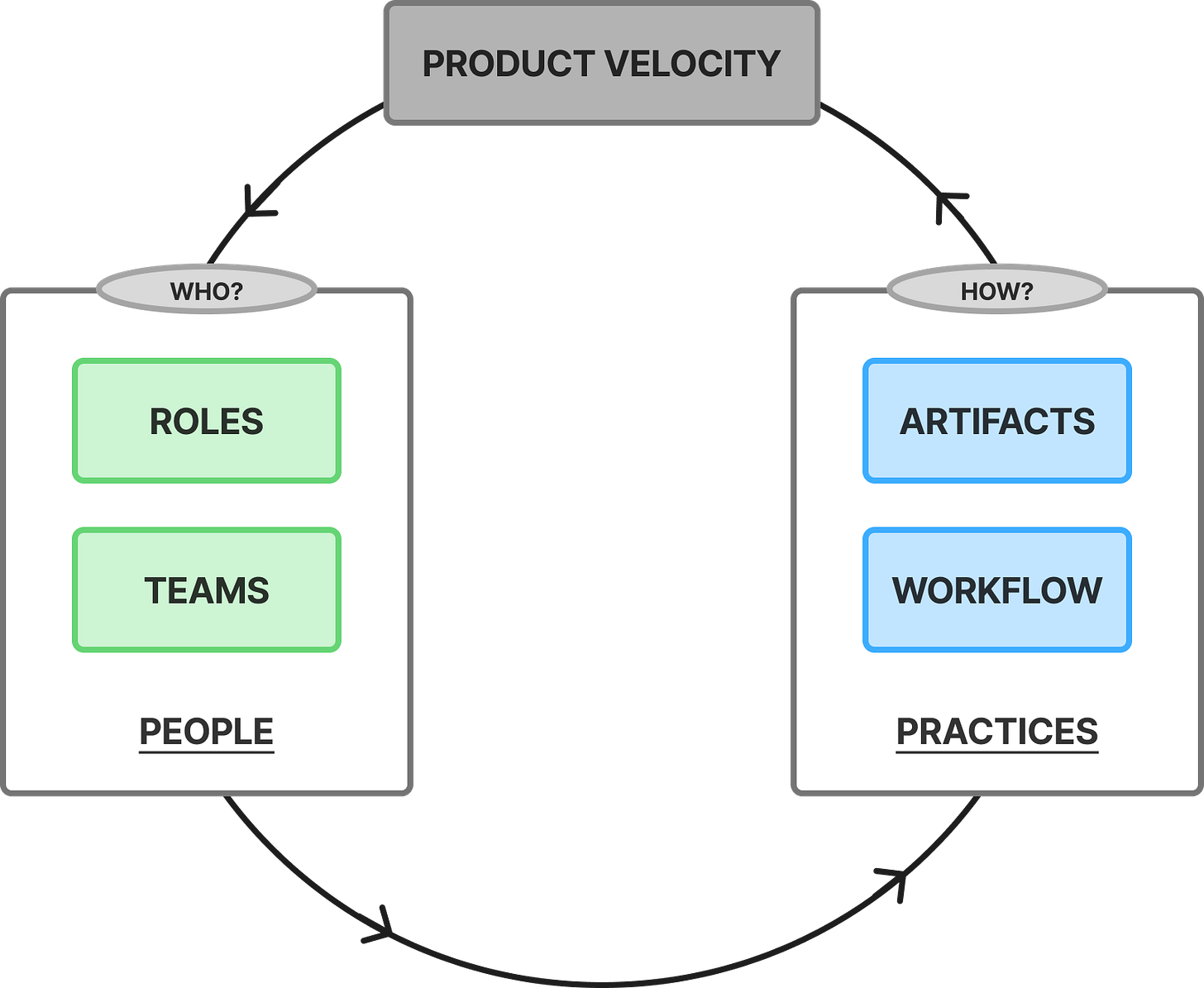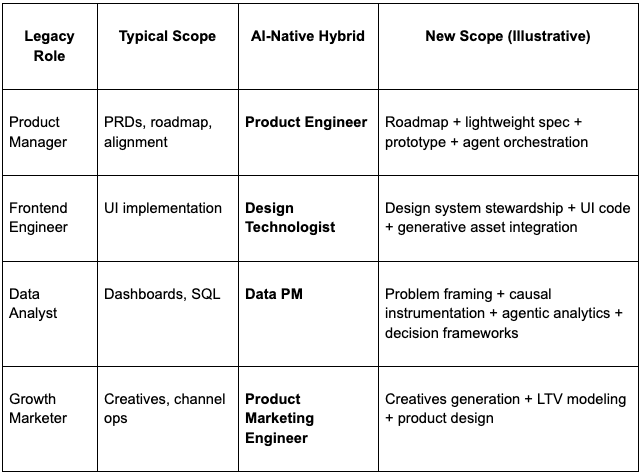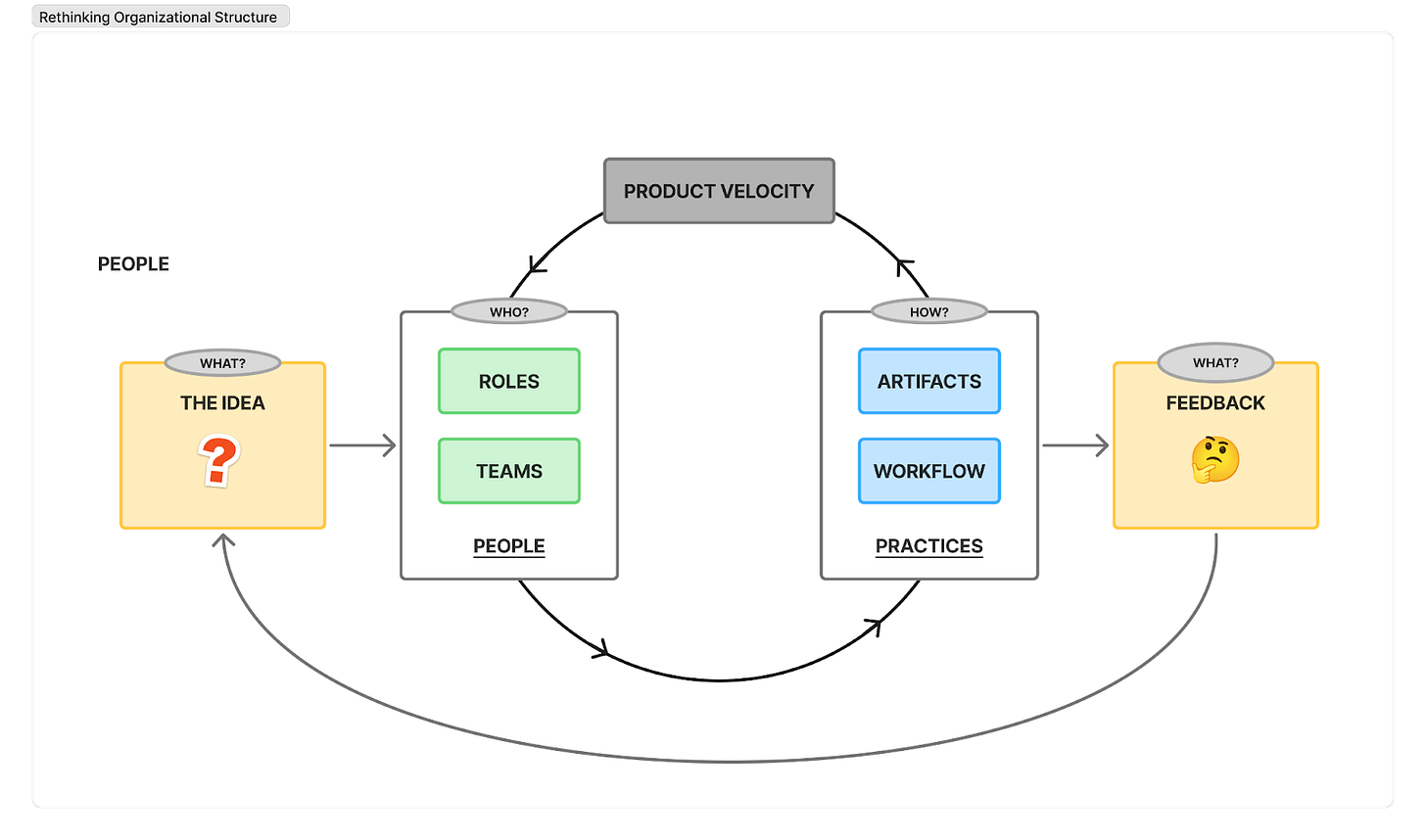The Organizational Meta: A New Blueprint for Work in the Age of AI
What League of Legends taught me about organizational transformation
The Game Has Changed
I’ve spent much of my career at the intersection of technology and human endeavor, from gaming to organizational design in large companies. In titles like League of Legends, the “meta” is the most effective tactic available—an emergent pattern of strategies, builds, and compositions that shifts as the game’s mechanics change.
When a patch drops, the meta doesn’t adjust—it transforms. Optimality is dynamic—it's a response to change.
Today, the rapid advancement of artificial intelligence (AI) is reshaping the way we work, challenging traditional roles, and forcing us to rethink the structure of organizations. The current approach of bolting AI onto existing organizational structures and processes is reactive and fails to capture the systemic value that AI promises.
The core problem is not a lack of tools or use cases, but a lack of a strategic framework for redesigning the organization itself.
We don’t know how far AI will ultimately advance—whether we stop at powerful narrow AI, reach artificial general intelligence (AGI), or one day confront artificial superintelligence (ASI). However, in the current transition, those unable to adapt and adjust will be dramatically disadvantaged.
This is where I introduce a concept I call The Organizational Meta.
In League of Legends, a meta shift changes the competitive environment and the optimal ways to win. The same thing is happening inside companies, except the "patch" is the relentless advance of AI capabilities.
In this context, the Organizational Meta refers to the optimal organizational structure that emerges based on AI's current capabilities and limitations.
Working definition: Organizational Meta is the current best configuration of roles, teams, workflows, and artifacts that maximizes outcomes, especially given AI’s evolving capabilities and constraints—reviewed and “patched” on a fixed cadence.
To win, leaders must stop reacting to the patch notes and start proactively designing their meta.
A New Physics of Organizations
We stand at an inflection point. The traditional physics of organizations—built on assumptions of human cognitive limits, communication costs, and specialized expertise—is breaking down. AI has changed the fundamental constants.
Consider what's actually happening:
Individuals with AI can perform tasks that once required entire departments
Cognitive work that took weeks now takes hours
Expertise that took years to develop can be synthesized in moments
Coordination overhead that justified management layers has evaporated
Yet most organizations still operate as if these changes are incremental optimizations rather than a phase transition. They're adding AI to existing roles, much like adding faster horses to carriages, without recognizing that the entire vehicle needs redesigning.
This isn't about job replacement. It's about something far more profound: the emergence of entirely new organizational structures optimized for human-AI collaboration.
The Organizational Meta isn't just a framework—it's an evolutionary imperative.
Rethinking Organizational Structure
Given the dramatic impact of AI on work, a maximally efficient and effective company should think about organizational structure from first principles.
More specifically, designing an appropriate Organizational Meta should be considered with a reconsideration of the organizational design of a company’s people (roles and teams) and practices (artifacts and workflows).
ROLES -> Hybridization and Compression
Traditional organizations evolved around a simple constraint: human limitations. We created roles because individuals couldn't hold all necessary expertise. We built hierarchies because coordination required dedicated overhead. We separated functions because expertise was specialized and siloed.
AI obliterates these constraints, creating what I call the Compression Phenomenon. It manifests in two dimensions:
Intra-role compression: AI handles the routine, computational, and even some creative aspects within a role, leaving only the uniquely human elements.
Inter-role compression: Entire roles merge as AI eliminates the friction between domains. The boundaries between product, engineering, design, and marketing dissolve.
But here's what most miss: compression isn't just about efficiency. It's about emergence. When you compress carbon under extreme pressure, you don't get smaller carbon—you get diamond. Similarly, role compression creates entirely new capabilities.
A Product Engineer isn't just a product manager who codes or an engineer who thinks about users. They're something qualitatively different: someone who can hold the entire product in their head, from user insight to implementation detail, orchestrating AI to handle what would have required a team of specialists.
In the traditional organization, the atomic unit was the individual role. In the AI-native organization, it's the human-AI hybrid capability. Let me make this concrete:
Traditional Atomic Unit: Frontend Engineer
Writes React components
Implements designs
Debugs browser issues
Optimizes performance
New Atomic Unit: Design Technologist + AI Ensemble
Envisions user experiences and prompts AI to generate multiple implementations
Orchestrates AI agents to create, test, and refine design systems
Focuses on taste, judgment, and creative vision while AI handles execution
Can produce in a day what previously took a team weeks
The crucial insight: the new atomic unit isn't smaller—it can be much more powerful. It combines human judgment, creativity, and context with AI's computational power and consistency.
We'll likely see the emergence of an increase in hybrid positions:
Product Engineers: Combining technical implementation with product thinking
Design Technologists: Merging creative design with technical execution
Data PMs: Fusing data analysis with product strategy
Growth Marketer: Combining growth techniques with product design
Example Potential Role Evolution:
These are just examples, but the specific “role+1” (or more than one role) and adjusted scope of work per role to maximally drive efficiency will be product-specific.
Where interfaces become clean, hybrids dominate; where interfaces stay messy, roles decompose more slowly, and artifacts carry more load.
TEAMS -> Smaller, Faster, Cross-Functional
As roles shift and AI subsumes more and more work, the most efficient and effective team structure should be thoughtfully and holistically reconsidered.
Do you need 10 engineers or 2?
Do you need 300 people generating ad creatives or 3?
Do you need 5 engineers, 3 product managers, and 2 marketers, or do you need 2 product marketing engineers?
The implications of optimized role and team changes should become clear:
A 5-person team with AI might outperform a traditional 20-person team
Reduced coordination overhead
Faster decision-making cycles
More ownership and fewer blockers per individual
These newly designed team structures will be based on what maximizes product velocity and outcomes.
Furthermore, we need to become comfortable with teams that dynamically form and reform based on specific challenges or problems, rather than relying on fixed departments.
ARTIFACTS -> Complete Redesign + Usability of Informal Knowledge
Work artifacts, such as documents, diagrams, and data analysis, are generated for a specific purpose and audience.
The modern enterprise needs to design artifacts for the consumers it actually has. If an agent must read it, it needs structure—intent, constraints, evals, and state—not prose alone.
In the new world of AI, artifacts should be redesigned to consider what is required given 1. role compression and 2. how work artifacts will be consumed not just by humans but also by AI and agents.
If a design and engineering role is compressed into a single design engineering role, does the person designing a product feature necessarily need a complete design spec or PRD? Is there another form of document that would better serve the needs of that new role, given their objective?
What if the engineer is an AI? An AI generating code may be better served by an extensive prompt optimized for an LLM rather than a traditional design spec or PRD.
The bigger point here is that revised roles and AI/agents create a need to thoroughly re-evaluate whether the workplace artifacts currently used are optimally serving their purpose.
An additional opportunity in the new world of AI is the potential to generate artifacts from informal or semi-formal corporate knowledge.
While formal artifacts are standardized and designed for usability and shareability within an enterprise, we find two issues when it comes to informal or semi-formal enterprise knowledge:
Information Defection: A lot of information that should be codified and shared in formal documents often leaks into informal systems. Lack of discipline and the practical realities of day-to-day work frequently lead to information leaking into verbal conversations, notes, and untracked Figjam boards.
Informal Information Loss: Valuable enterprise knowledge captured in informal or semi-formal systems is not tracked, not accessible or shareable, and lacks a mechanism for surfacing to other employees who may find the information valuable.
Hence, another significant area of productivity unlock will come from AI’s ability to capture, formalize, store, and share previously informal and semi-formal knowledge into usable artifacts.
As a specific example, imagine a team evaluating several vendors to help determine what analytics platform they would like to use. They may have whiteboard sessions, face-to-face discussions, and many Zoom calls with different vendors. Various team members maintain their informal notes. Meetings are then called, followed by discussions, and ultimately, a decision framework is established. At some point, a document may be created to codify how the decision was made.
However, a more usable artifact would be if every discussion were summarized and structured into a formal “Analytics Vendors Evaluation” document of some kind that automatically gets updated with new meeting notes. A framework for evaluation could have been pre-determined, automatically filled in, and presented for review by an AI. Every meeting that any team member takes could get recorded, transcribed, and relevant information automatically updated in the Analytics Vendors Evaluation document. An agent watching that doc could automatically alert teammates to new information or proactively identify a new data comparison point to research and fill in. AI could also be used to critically analyze the decision framework, suggesting improvements and updating any missing information via agents.
Hence, the key point here is that the impact of AI on enterprise artifacts remains at the very early stages of driving productivity gains. To drive higher productivity from artifacts, they should be reconsidered entirely and redesigned. Further, a potential massive unlock for additional productivity could be through the creation of new AI-native artifacts that contemplate the capabilities of AI and agents from first principles.
Key Principles:
Critically re-evaluate existing enterprise artifacts to determine whether they are still necessary. What happens if some of these artifacts are deleted (maybe nothing)?
Redesign artifacts to be maximally efficient and effective based on updated roles and to better work with AI.
Make artifact surfaces agentable. Replace narrative-only documents with structured intents (goals, constraints, acceptance criteria), explicit state, and linked evals.
Treat informal knowledge as a first-class input to agent-legible artifacts: capture, structure, and surface it in schemas that agents can consume.
WORKFLOWS -> Adapt for AI, Automation, and Agents
Workflows should consider newly designed roles, team structures, updated artifact designs, and most importantly, how AI fits into the picture—especially with the integration of agents to automate and coordinate different kinds of work.
If you believe that product velocity will be the primary basis of competition in the future, workflow optimization will be a critical component of designing an organization for super high velocity.
Current workflows designed with legacy departmental hand-offs, alignment/coordination, and human labor in mind should be reconsidered. Every major workflow should be broken down into component workflow steps, and every step should consider AI and agents.
Critical: Any non-agentable workflow step becomes the rate limiter of product velocity.
Most importantly, specific workflow steps that block AI or agentic use should be redesigned. For instance, if a current workflow involves updating an Excel spreadsheet with pricing data, which is then uploaded to a website, redesigning the pricing data to be stored as a file or within a database that can be more easily modified by AI/agents should be considered.
Durable advantage accrues to organizations that minimize non-agentable surfaces (private file silos, tacit approvals, ad hoc formats).
Human verification or review points should also be integrated into the workflow where there is a risk of AI error or hallucinations.
Understanding AI’s Limitations
Design begins with constraints. As AI continues to improve, the best way to optimally design for organizational meta may be through having a deep understanding of AI’s limitations.
More specifically, consider these potential areas for limitations by AI:
Creativity – Generating genuinely novel, resonant ideas that connect with culture, emotion, and human experience.
Multi-Step, Long-Horizon Work – Managing work that unfolds over many steps and months (or years) without losing the thread.
Complex Collaboration – Integrating new, unpredictable inputs from multiple people and disciplines into a coherent whole.
Judgment – Making nuanced and contextual decisions when data is incomplete or ambiguous. Ability to do proper eval and determine hallucinations.
Contextual Awareness – Understanding the specialized, nuanced, and domain-specific details that affect decisions and execution.
The areas where AI has constraints should help define where humans add the most value.
Assign agents where failure is cheap and evals are strong; assign humans where failure is costly, context is tacit, or goals are renegotiated in flight. Everything else—roles, teams, artifacts, workflows—flows from this constraint surface.
Looking back at our People and Process framework, we can see that the use of AI may dramatically increase Product Velocity through human + AI hybrid work. However, determining what to build and evaluating product outputs may (at least currently) still be best executed by humans.
The Organizational Orchestrator Role
In this new world, someone must architect the organization itself. Not manage it—architect it. This role, which I call the Organizational Orchestrator, becomes perhaps the most critical in any company.
The Orchestrator doesn't manage people or projects. They design the system within which work happens. Their responsibilities:
Capability Architecture: Maintain a living map of what is AI-led vs. human-led, continuously experiment with AI, and understand current limitations.
Meta Optimization: Recompose roles and teams and redesign artifacts and workflows to optimize efficiency and effectiveness.
Evaluation: Always monitor the effectiveness of roles/teams/artifacts/workflows. Create simple KPIs to demonstrate efficiency and effectiveness. Require reversible changes by default, with explicit rollback plans.
Returns to Intelligence: Re-allocate human time and agent capacity to the current bottleneck where a marginal unit of intelligence yields the largest cycle-time or outcome gain.
This isn't a Chief Technology Officer or a Chief Operating Officer. It's something new: someone who thinks about organizations the way a game designer thinks about game balance. They understand that in a world of rapidly evolving AI, organizational structure itself must be dynamic.
The orchestrator is a hybrid: technologist (reads/defines evals, understands agent limits), organizational designer (recomputes roles and teams), operator (optimizes for cycle time and outcomes), and ethicist (knows when to add friction). Treat it as a capability to build, not a project to assign.
In doing so, the following three questions should be deeply considered:
Deliverables – What are we producing, and what makes it good?
Objectives – What are we trying to achieve, and how can AI help?
Effectiveness – What’s now possible—or possible to improve—because of AI?
These questions anchor the search for alpha in organizational design.
Conclusion: Why the Organizational Meta Matters
Just like with every technological shift in the past, new winners and losers will be created by this new environment of AI.
In the grind of day-to-day life, we can underappreciate or forget that AI is the most transformative and impactful technology in human history and likely the history of Earth.
Regulation, culture, and infrastructure will modulate the pace. I may be wrong on timing, but I doubt I’m wrong on direction.
Organizations that cling to rigid, vertically siloed structures will find themselves uncompetitive. The winners will be the ones who can continuously adapt their Organizational Meta to align human strengths with AI capabilities.






